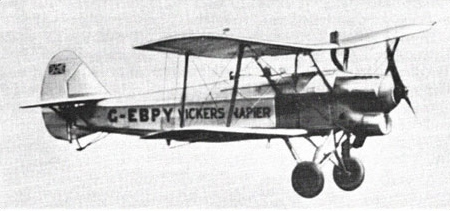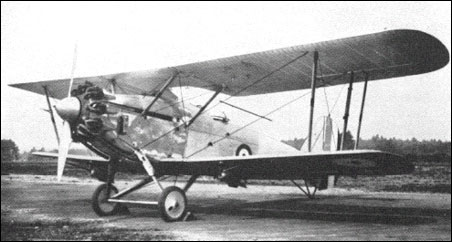|
Gloster Goral
The Gloster Goral was a single-engined two-seat biplane built to an Air Ministry contract for a general-purpose military aircraft in the late 1920s. It did not win the contest and only one was built. Development In 1927, driven by conflicting pressures of an ageing, World War I aircraft stock and the continual need for economy the Air Ministry was attracted by the idea of a general-purpose, multi-tasking machine which used many components from the large stocks of Airco DH.9A accumulated ten years before. The result was Air Ministry specification 26/27, which also encouraged the use of a metal airframe for use overseas and of the abundant Napier Lion engine. At least eight manufacturers responded and the Goral was Gloster's submission. The Goral was an all-metal framed, fabric-covered biplane using DH9A wings of two-bay construction and of slight stagger, with parallel interplane struts. There were ailerons on all wings. The fuselage was oval in cross section and quite slim. ... [...More Info...] [...Related Items...] OR: [Wikipedia] [Google] [Baidu] |
WikiProject Aircraft
A WikiProject, or Wikiproject, is a Wikimedia movement affinity group for contributors with shared goals. WikiProjects are prevalent within the largest wiki, Wikipedia, and exist to varying degrees within sister projects such as Wiktionary, Wikiquote, Wikidata, and Wikisource. They also exist in different languages, and translation of articles is a form of their collaboration. During the COVID-19 pandemic, CBS News noted the role of Wikipedia's WikiProject Medicine in maintaining the accuracy of articles related to the disease. Another WikiProject that has drawn attention is WikiProject Women Scientists, which was profiled by '' Smithsonian'' for its efforts to improve coverage of women scientists which the profile noted had "helped increase the number of female scientists on Wikipedia from around 1,600 to over 5,000". On Wikipedia Some Wikipedia WikiProjects are substantial enough to engage in cooperative activities with outside organizations relevant to the field at issue. For e ... [...More Info...] [...Related Items...] OR: [Wikipedia] [Google] [Baidu] |
Aircraft First Flown In 1927
An aircraft is a vehicle that is able to fly by gaining support from the air. It counters the force of gravity by using either static lift or by using the dynamic lift of an airfoil, or in a few cases the downward thrust from jet engines. Common examples of aircraft include airplanes, helicopters, airships (including blimps), gliders, paramotors, and hot air balloons. The human activity that surrounds aircraft is called ''aviation''. The science of aviation, including designing and building aircraft, is called ''aeronautics.'' Crewed aircraft are flown by an onboard pilot, but unmanned aerial vehicles may be remotely controlled or self-controlled by onboard computers. Aircraft may be classified by different criteria, such as lift type, aircraft propulsion, usage and others. History Flying model craft and stories of manned flight go back many centuries; however, the first manned ascent — and safe descent — in modern times took place by larger hot-air ball ... [...More Info...] [...Related Items...] OR: [Wikipedia] [Google] [Baidu] |
Gloster Aircraft
The Gloster Aircraft Company was a British aircraft manufacturer from 1917 to 1963. Founded as the Gloucestershire Aircraft Company Limited during the First World War, with the aircraft construction activities of H H Martyn & Co Ltd of Cheltenham, England it produced fighters during the war. It was renamed later as foreigners found 'Gloucestershire' difficult to pronounce. It later became part of the Hawker Siddeley group and the Gloster name disappeared in 1963. Gloster designed and built several fighters that equipped the British Royal Air Force (RAF) during the interwar years including the Gladiator, the RAF's last biplane fighter. The company built most of the wartime production of Hawker Hurricanes and Hawker Typhoons for their parent company Hawker Siddeley while its design office was working on the first British jet aircraft, the E.28/39 experimental aircraft. This was followed by the Meteor, the RAF's first jet-powered fighter and the only Allied jet fighter to be pu ... [...More Info...] [...Related Items...] OR: [Wikipedia] [Google] [Baidu] |
1920s British Aircraft
Nineteen or 19 may refer to: * 19 (number), the natural number following 18 and preceding 20 * one of the years 19 BC, AD 19, 1919, 2019 Films * ''19'' (film), a 2001 Japanese film * ''Nineteen'' (film), a 1987 science fiction film Music * 19 (band), a Japanese pop music duo Albums * ''19'' (Adele album), 2008 * ''19'', a 2003 album by Alsou * ''19'', a 2006 album by Evan Yo * ''19'', a 2018 album by MHD * ''19'', one half of the double album ''63/19'' by Kool A.D. * ''Number Nineteen'', a 1971 album by American jazz pianist Mal Waldron * ''XIX'' (EP), a 2019 EP by 1the9 Songs * "19" (song), a 1985 song by British musician Paul Hardcastle. * "Nineteen", a song by Bad4Good from the 1992 album ''Refugee'' * "Nineteen", a song by Karma to Burn from the 2001 album ''Almost Heathen''. * "Nineteen" (song), a 2007 song by American singer Billy Ray Cyrus. * "Nineteen", a song by Tegan and Sara from the 2007 album '' The Con''. * "XIX" (song), a 2014 song by Slipknot. ... [...More Info...] [...Related Items...] OR: [Wikipedia] [Google] [Baidu] |
Flight International
''Flight International'' is a monthly magazine focused on aerospace. Published in the United Kingdom and founded in 1909 as "A Journal devoted to the Interests, Practice, and Progress of Aerial Locomotion and Transport", it is the world's oldest continuously published aviation news magazine. ''Flight International'' is published by DVV Media Group. Competitors include Jane's Information Group and ''Aviation Week''. Former editors of, and contributors include H. F. King, Bill Gunston, John W. R. Taylor and David Learmount. History The founder and first editor of ''Flight'' was Stanley Spooner. He was also the creator and editor of ''The Automotor Journal'', originally titled ''The Automotor Journal and Horseless Vehicle''.Guide To British Industrial History: Biographies: ''Stan ... [...More Info...] [...Related Items...] OR: [Wikipedia] [Google] [Baidu] |
List Of Aircraft (G-Gn)
This is a list of aircraft in alphabetical order beginning with 'G'. G-Gn G-Aerosports * G-Aerosports Archon SF/1 * G-Aerosports Archon SF-2T * G-Aerosports G-802 Atairon G/B Aircraft (Glenn Beets) does not fly well * Beets G/B Special G1 Aviation (Le Thor, France) *G1 Aviation G1 Gabardini (''Aeroplani Gabardini'' / ''Società Anonima Gabardini per l'Incremento dell'Aviazione'') also see:SIA * Gabardini Hydravion 1910 (Monaco-monoplano) * Gabardini Monoplano Gabarda 1913 * Gabardini Monoplano Checca ('Francesca') Ground trainer * Gabardini Monoplano ground trainer * Gabardini Monoplano Scuola (School) * Gabardini Monoplano Vuolo (Flight) * Gabardini Idrovolante 1913 'Gabarda' on twin, wooden float gear * Gabardini HD - Hanriot HD.1 used at the Scuola Aviazione di Cameri * Gabardini A.300/6 - 3-seat recce biplane, mod. Ansaldo A.300/4* * Gabardini G.3 1914 'Biplano' 1-/2-seat biplane trainer * Gabardini G.4 * Gabardini G-4 bis: Single-seat vers. 1 x 120 hp ... [...More Info...] [...Related Items...] OR: [Wikipedia] [Google] [Baidu] |
Vickers Vixen
The Vickers Vixen was a British general-purpose biplane of the 1920s. Designed and developed by Vickers in a number of variants, with 18 Vixen Mark V sold to Chile. A prototype of a version with metal wings was built as the Vickers Vivid. The Vixen also formed the basis of the closely related Venture and Valparaiso aircraft, which were also built and sold in small numbers in the 1920s Development and design In 1922, Vickers designed a two-seat biplane as a private venture as a possible replacement for the Airco DH.9A and Bristol F.2 Fighter. Building on the experience of the unsuccessful wartime FB.14 fighter-reconnaissance aircraft, the Vixen was a single-bay biplane with a steel tube fuselage and wooden wings, powered by a 450 hp (340 kW) Napier Lion engine. The first prototype aircraft, the Type 71 Vixen I, given the civil registration ''G-EBEC'', flew in February 1923. It was tested at Martlesham Heath and showed good performance, prompting modification to a day ... [...More Info...] [...Related Items...] OR: [Wikipedia] [Google] [Baidu] |
Vickers 131 Valiant
The Vickers Type 131 Valiant was a British general-purpose biplane produced by Vickers in 1927, with the intention of replacing the Royal Air Force's Airco DH.9As, but was unsuccessful, with only a single example built, which was sold to Chile. Development and design In 1926, based on experience with the wooden-winged Vickers Vixen biplane, where the wings proved vulnerable to extremes of temperature and humidity, designed a set of metal wings for the Vixen, with which it became the Vickers Vivid, and in parallel, designed an all-metal general purpose biplane, the Vickers Type 131, hoping to replace the DH.9A in that role.Andrews and Morgan, pp. 187-188. In 1927, the British Air Ministry issued Specification 26/27 for a DH.9A replacement which, to save money, had to use as many components of the DH.9A as possible because the RAF held large stocks of DH.9A spares. Vickers submitted the Type 131 design to the Ministry but, as it did not make use of the required DH9A component ... [...More Info...] [...Related Items...] OR: [Wikipedia] [Google] [Baidu] |
Potez 25
Potez 25 (also written as Potez XXV) was a French twin-seat, single-engine biplane designed during the 1920s. A multi-purpose fighter-bomber, it was designed as a line aircraft and used in a variety of roles, including fighter and escort missions, tactical bombing and reconnaissance missions. In the late 1920s and early 1930s, Potez 25 was the standard multi-purpose aircraft of over 20 air forces, including French and Polish. It was also popular among private operators, notably mail transport companies. The aircraft was further developed into the 25M, a standard parasol-wing monoplane, which never entered production. Design and development In 1923, the Avions Henry Potez aircraft works started production of a successful Potez 15 reconnaissance biplane. Basing on experience gathered during the construction of that aircraft, Henry Potez started working on a new design of a heavier and faster multi-purpose aircraft. Designated Potez XXV or Potez 25, the prototype was built alrea ... [...More Info...] [...Related Items...] OR: [Wikipedia] [Google] [Baidu] |
Fairey Ferret
The Fairey Ferret was a 1930s British general-purpose biplane designed and built by the Fairey Aviation Company. It performed well in trials but was not ordered into production. Development The Ferret was designed to meet a Fleet Air Arm requirement defined by specification 37/22 for a reconnaissance aircraft; it was the company's first all-metal design. With a lack of interest from the FAA the company proposed the design to meet a Royal Air Force requirement for a general-purpose biplane. The company built three prototypes, two were three-seaters (to meet the naval requirement) and the third was a two-seater. The two-seater Ferret III was also fitted with a new Fairey-designed high-speed gun mounting in the rear cockpit. The first prototype first flew in June 1925 powered by a 400 hp (298 kW) Armstrong Siddeley Jaguar IV radial engine. The other two aircraft had a nine-inch extension to the wingspan and both were fitted with a 425 hp (317 kW) Bristol Jupit ... [...More Info...] [...Related Items...] OR: [Wikipedia] [Google] [Baidu] |



